When I received the topic of the month, I was traveling in India. Sometimes, a place triggers a memory of events that would otherwise lie buried in the recesses of time. Call it happenstance but at least for this topic, I was in the right place! The minute I read the theme, the memory of a news article that occurred over 35 years ago flashed past my mind’s eye. My parents had just bought us a brand new washing machine. My little brother and I were pretty excited about this new contraption and would spend hours watching mom put the clothes into the tub to wash and pull them out clean. We were in awe of this magical yellow machine and vied to be lifted up by mom, dad, aunt, uncle or anyone taller than the tub, to get a quick peek of the inside of the rotating tub. One day while we were playing in the hall, we overheard my aunts and dad discussing a news article. A young boy had placed his brother in the washing machine and had turned it on. The reason he gave his grief-stricken parents left an indelible impression on my young mind. He had wanted to make his baby brother white like the clothes in the wash. The rest is history. The washing machine was returned and we never owned a washing machine till much later.

I share this memory not to traumatize the reader but in the hope that what I have to say next has some impact on our everyday brush with the topic of skin color. A flippant remark by a school teacher about being white like the uniform shirt one wears versus being dark like the skirt one wears, a serious admonishing that young girls must be fair to get a good groom, a nonchalant remark by the roadside Romeo about only falling in love with the jasmine-colored fair maiden; these and other brushes with skin color on-screen and off-screen (life imitating art and art, in turn, imitating life) should not be ignored but confronted.
The Indian media is very blatant in its exhibition of bias toward a “fair” and “lovely” skin tone. A heroine is cast based on her skin tone (e.g., a British woman in Bollywood and Tollywood movies), a heroine is roasted for her skin tone (e.g., an Indian heroine in a recent episode of a comedy show), and yet another heroine is denied the lead role for her skin tone. Although, we may not confront such statements and brush them off as statements made by nincompoops, unbeknownst to us, some of these attitudes may become a part of our “unconscious bias” due to an increased exposure to media and pop culture that plants these ideas in our unconscious. All such brushes with real-life color bias become a part of our “unconscious” biases, ingrained and reinforced by the media from a very young age.

Unconscious biases are social stereotypes about certain groups of people that individuals form outside their own conscious awareness. Everyone holds unconscious beliefs about various social and identity groups, and these biases stem from one’s tendency to organize social worlds by categorizing. Research on unconscious bias shows that it is far more prevalent than conscious bias. Every day, certain circumstances and situations can activate our unconscious belief system, which is often incompatible with our conscious values. For example, biases may be more prevalent when traveling to a new location or when working on a team under time pressure. Unconscious biases are not eternal and we can take steps to limit their impact on our thoughts and behaviors (Dasgupta, 2013).
According to a recent report, Gender bias without borders (2014), on the Geena Davis Institute on Gender in Media’s website, for every hour of television a girl watches, the fewer opportunities she thinks she has in life and the more likely she is to link her physical appearance to self-worth. The report propounds that a “psychological ceiling”, installed at an early age, continues to influence a girl’s decisions as an adult. I’m sure many of my readers can attest that the images we see on television or cinema have a profound effect on how we see the world and our role in it.
I believe that when considering strategies to address unconscious bias one must not only consider ways to address their own unconscious bias but must also reflect upon how they can change such collective biases in society. Recognizing one’s biases is the first step and understanding the nature of one’s biases in a more open manner is essential. But how do we create opportunities to have discussions with others, especially with those who present the bias very outwardly? This is crucial if we want to bring about a cultural change. We can begin by sharing our biases, which in turn can help others feel more confident about exploring their own biases. Having these conversations in a safe space will increase the likelihood of individuals being more open to alternative perspectives and viewpoints.

The next time you see something on television that is not right and promotes a negative bias about any social group or characteristic, call it out. Whether you are with family or at work or hanging out with your buddies, calling out someone on his or her biases can help people become more conscious of the decisions they are making. This is an important first step in actually making a change. Becoming more aware of the unconscious decisions we’re making could help slowly move the needle in the right direction. We have to create that openness in our culture in order for positive concepts about color or any other characteristic to take root. By examining our own behaviors we can begin to probe our societal culture so that our nation’s culture mirrors that of a globalized world. So, let us make a pledge today to embrace and influence all that is good about our individual differences on conduits such as television and cinema. After all, who doesn’t love Ranbir Kapoor or Kajol?
References :
Dasgupta, N. (2013). Implicit Attitudes and Beliefs Adapt to Situations: A Decade of Research on the Malleability of Implicit Prejudice, Stereotypes, and the Self-Concept. Advances in Experimental Social Psychology, 47, 233-279.
Dr. Stacy L. Smith, Marc Choueiti, & Dr. Katherine Pieper with assistance from
Yu-Ting Liu & Christine Song Media, Diversity, & Social Change Initiative USC Annenberg (2014). Gender Bias without Borders – An Investigation of Female Characters in Popular Films across 11 Countries.
Meet the author: Jay Polaki, SHRM-SCP, SPHR

Jay Polaki is the Founder of HR Godzilla and serves as a consultant and owner for the firm. Jay has spent the last seventeen years in several leadership positions across industries, as a business partner and executive human resources consultant. Her experience spans all facets of human resource management and organizational development.
She specializes in the areas of business management, human resource strategy development, establishing and implementing human resource policy and practices, and high-performance leadership development.
Jay is also the Founder of Global Indian Professional Network, a non-profit focused on professional development for Indian-Origin professionals and the advancement of global Indians in business. Active in the community, Jay is a member of a variety of local and national non-profits focused on education; diversity; leadership; and the advancement and support of women.
While Jay handles clients internationally across all HR Godzilla markets, she is primarily located in Maryland, USA.
Please note: The views, opinions and beliefs expressed by the authors in the articles on the blog are theirs alone and do not necessarily reflect those of Lean In India.